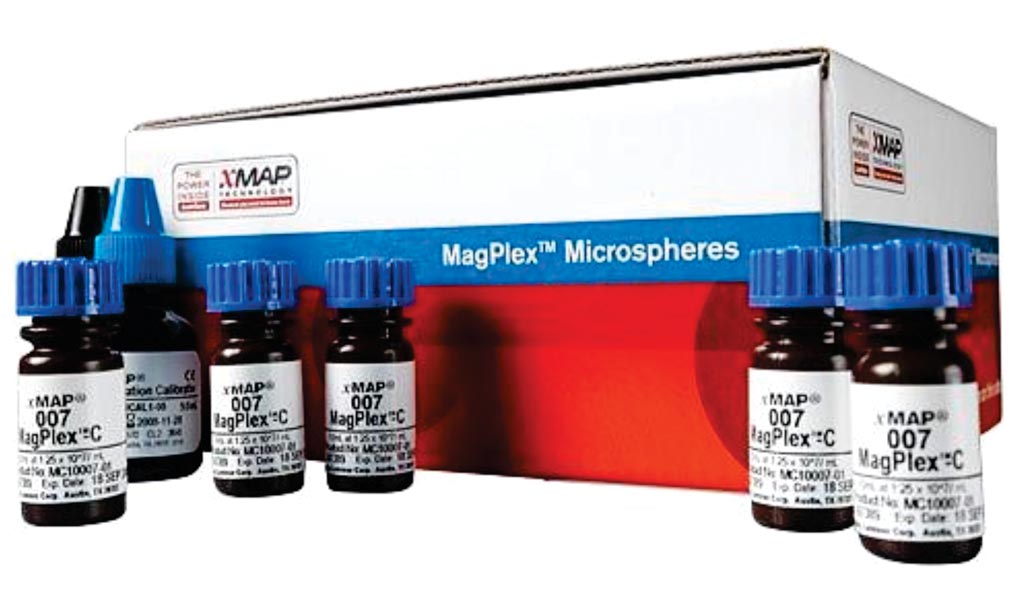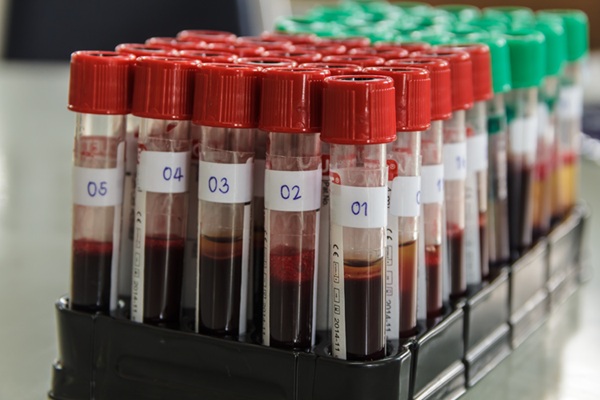Multiplex Microsphere Immunoassay Identifies Three Flavivirus Infections
|
By LabMedica International staff writers Posted on 19 Sep 2019 |

Image: The MagPlex Multiplexing Microspheres (Photo courtesy of Luminex).
The explosive spread of Zika virus (ZIKV) and associated complications in flavivirus-endemic regions underscore the need for sensitive and specific serodiagnostic tests to distinguish ZIKV, dengue virus (DENV) and other flavivirus infections.
ZIKV is a member of the genus Flavivirus of the family Flaviviridae, which includes several pathogenic mosquito-borne viruses in different serocomplexes. The four serotypes of dengue virus (DENV) belong to the DENV serocomplex; West Nile virus (WNV) and Japanese encephalitis virus (JEV) to the JEV serocomplex; yellow fever virus (YFV) as a single member; and ZIKV.
Tropical medicine specialists at the University of Hawaii at Manoa, (Honolulu, HI, USA) and their colleagues developed a high-throughput and multiplex IgG microsphere immunoassay (MIA) using the NS1 proteins of DENV1-DENV4, ZIKV and West Nile virus (WNV) to test samples from reverse-transcription-polymerase-chain reaction-confirmed cases, including primary DENV1, DENV2, DENV3, WNV and ZIKV infections, secondary DENV infection, and ZIKV infection with previous DENV infection.
The NS1 gene (corresponding to amino acid residues 1–352) of ZIKV (HPF2013 strain) with a His-tag at the C-terminus was codon-optimized. Six purified NS1 proteins, bovine serum albumin (BSA) and PBS (as negative antigen control) were coupled individually onto eight types of magnetic carboxylated microsphere beads containing different fluorophores (MagPlexTM-C) using two-step carbodiimide process at room temperature. Microsphere immunoassays (MIA) were performed and read by a Luminex 200 machine. Enzyme-linked immunosorbent assays were performed for DENV1-, DENV2-, DENV3-, and ZIKV-NS1 IgG.
The scientists reported that a combination of four DENV NS1 IgG MIAs revealed a sensitivity of 94.3% and specificity of 97.2% to detect DENV infection. The ZIKV and WNV NS1 IgG MIAs had a sensitivity/specificity of 100%/87.9% and 86.1%/78.4%, respectively. A positive correlation was found between the readouts of ELISA and MIA for the different NS1 tested. Based on the ratio of relative median fluorescence intensity of ZIKV NS1 to DENV1 NS1, the IgG MIA can distinguish ZIKV infection with previous DENV infection and secondary DENV infection with a sensitivity of 88.9%–90.0% and specificity of 91.7%–100.0%.
The authors concluded that the multiplex and high-throughput assay could be applied to serodiagnosis and serosurveillance of DENV, ZIKV and WNV infections in endemic regions. The study was published on August 23, 2019, in the journal PLOS Neglected Tropical Diseases.
Related Links:
University of Hawaii at Manoa
ZIKV is a member of the genus Flavivirus of the family Flaviviridae, which includes several pathogenic mosquito-borne viruses in different serocomplexes. The four serotypes of dengue virus (DENV) belong to the DENV serocomplex; West Nile virus (WNV) and Japanese encephalitis virus (JEV) to the JEV serocomplex; yellow fever virus (YFV) as a single member; and ZIKV.
Tropical medicine specialists at the University of Hawaii at Manoa, (Honolulu, HI, USA) and their colleagues developed a high-throughput and multiplex IgG microsphere immunoassay (MIA) using the NS1 proteins of DENV1-DENV4, ZIKV and West Nile virus (WNV) to test samples from reverse-transcription-polymerase-chain reaction-confirmed cases, including primary DENV1, DENV2, DENV3, WNV and ZIKV infections, secondary DENV infection, and ZIKV infection with previous DENV infection.
The NS1 gene (corresponding to amino acid residues 1–352) of ZIKV (HPF2013 strain) with a His-tag at the C-terminus was codon-optimized. Six purified NS1 proteins, bovine serum albumin (BSA) and PBS (as negative antigen control) were coupled individually onto eight types of magnetic carboxylated microsphere beads containing different fluorophores (MagPlexTM-C) using two-step carbodiimide process at room temperature. Microsphere immunoassays (MIA) were performed and read by a Luminex 200 machine. Enzyme-linked immunosorbent assays were performed for DENV1-, DENV2-, DENV3-, and ZIKV-NS1 IgG.
The scientists reported that a combination of four DENV NS1 IgG MIAs revealed a sensitivity of 94.3% and specificity of 97.2% to detect DENV infection. The ZIKV and WNV NS1 IgG MIAs had a sensitivity/specificity of 100%/87.9% and 86.1%/78.4%, respectively. A positive correlation was found between the readouts of ELISA and MIA for the different NS1 tested. Based on the ratio of relative median fluorescence intensity of ZIKV NS1 to DENV1 NS1, the IgG MIA can distinguish ZIKV infection with previous DENV infection and secondary DENV infection with a sensitivity of 88.9%–90.0% and specificity of 91.7%–100.0%.
The authors concluded that the multiplex and high-throughput assay could be applied to serodiagnosis and serosurveillance of DENV, ZIKV and WNV infections in endemic regions. The study was published on August 23, 2019, in the journal PLOS Neglected Tropical Diseases.
Related Links:
University of Hawaii at Manoa
Latest Microbiology News
- 15-Minute Blood Test Diagnoses Life-Threatening Infections in Children
- High-Throughput Enteric Panels Detect Multiple GI Bacterial Infections from Single Stool Swab Sample
- Fast Noninvasive Bedside Test Uses Sugar Fingerprint to Detect Fungal Infections
- Rapid Sepsis Diagnostic Device to Enable Personalized Critical Care for ICU Patients
- Microfluidic Platform Assesses Neutrophil Function in Sepsis Patients
- New Diagnostic Method Confirms Sepsis Infections Earlier
- New Markers Could Predict Risk of Severe Chlamydia Infection
- Portable Spectroscopy Rapidly and Noninvasively Detects Bacterial Species in Vaginal Fluid
- CRISPR-Based Saliva Test Detects Tuberculosis Directly from Sputum
- Urine-Based Assay Diagnoses Common Lung Infection in Immunocompromised People
- Saliva Test Detects Implant-Related Microbial Risks
- New Platform Leverages AI and Quantum Computing to Predict Salmonella Antimicrobial Resistance
- Early Detection of Gut Microbiota Metabolite Linked to Atherosclerosis Could Revolutionize Diagnosis
- Viral Load Tests Can Help Predict Mpox Severity
- Gut Microbiota Analysis Enables Early and Non-Invasive Detection of Gestational Diabetes
- Credit Card-Sized Test Boosts TB Detection in HIV Hotspots
Channels
Clinical Chemistry
view channel
VOCs Show Promise for Early Multi-Cancer Detection
Early cancer detection is critical to improving survival rates, but most current screening methods focus on individual cancer types and often involve invasive procedures. This makes it difficult to identify... Read more
Portable Raman Spectroscopy Offers Cost-Effective Kidney Disease Diagnosis at POC
Kidney disease is typically diagnosed through blood or urine tests, often when patients present with symptoms such as blood in urine, shortness of breath, or weight loss. While these tests are common,... Read moreMolecular Diagnostics
view channel
New Biomarker Panel to Improve Heart Failure Diagnosis in Women
Heart failure affects millions worldwide, yet many women are still misdiagnosed or diagnosed too late. Although heart failure broadly means the heart cannot pump enough blood to the body’s cells, its two... Read more
Dual Blood Biomarkers Improve ALS Diagnostic Accuracy
Diagnosing amyotrophic lateral sclerosis (ALS) remains difficult even with advanced imaging and genetic tools, especially when clinicians must distinguish it from other neurodegenerative conditions that... Read moreHematology
view channel
ADLM’s New Coagulation Testing Guidance to Improve Care for Patients on Blood Thinners
Direct oral anticoagulants (DOACs) are one of the most common types of blood thinners. Patients take them to prevent a host of complications that could arise from blood clotting, including stroke, deep... Read more
Viscoelastic Testing Could Improve Treatment of Maternal Hemorrhage
Postpartum hemorrhage, severe bleeding after childbirth, remains one of the leading causes of maternal mortality worldwide, yet many of these deaths are preventable. Standard care can be hindered by delays... Read more
Pioneering Model Measures Radiation Exposure in Blood for Precise Cancer Treatments
Scientists have long focused on protecting organs near tumors during radiotherapy, but blood — a vital, circulating tissue — has largely been excluded from dose calculations. Each blood cell passing through... Read moreImmunology
view channel
Chip Captures Cancer Cells from Blood to Help Select Right Breast Cancer Treatment
Ductal carcinoma in situ (DCIS) accounts for about a quarter of all breast cancer cases and generally carries a good prognosis. This non-invasive form of the disease may or may not become life-threatening.... Read more
Blood-Based Liquid Biopsy Model Analyzes Immunotherapy Effectiveness
Immunotherapy has revolutionized cancer care by harnessing the immune system to fight tumors, yet predicting who will benefit remains a major challenge. Many patients undergo costly and taxing treatment... Read morePathology
view channel
Highly Sensitive Imaging Technique Detects Myelin Damage
Damage to myelin—the insulating layer that helps brain cells function efficiently—is a hallmark of many neurodegenerative diseases, age-related decline, and traumatic injuries. However, studying this damage... Read more
3D Genome Mapping Tool to Improve Diagnosis and Treatment of Genetic Diseases
Standard laboratory tests often fail to detect complex DNA rearrangements that underlie many genetic diseases. To bridge this diagnostic gap, researchers have developed a 3D chromosome mapping method that... Read more
New Molecular Analysis Tool to Improve Disease Diagnosis
Accurately distinguishing between similar biomolecules such as proteins is vital for biomedical research and diagnostics, yet existing analytical tools often fail to detect subtle structural or compositional... Read more
Tears Offer Noninvasive Alternative for Diagnosing Neurodegenerative Diseases
Diagnosing and monitoring eye and neurodegenerative diseases often requires invasive procedures to access ocular fluids. Ocular fluids like aqueous humor and vitreous humor contain valuable molecular information... Read moreTechnology
view channel
Portable Biosensor Diagnoses Psychiatric Disorders Using Saliva Samples
Early diagnosis of psychiatric disorders such as depression, schizophrenia, and bipolar disorder remains one of medicine’s most pressing challenges. Current diagnostic methods rely heavily on clinical... Read more
Cell-Sorting Device Uses Electromagnetic Levitation to Precisely Direct Cell Movement
Sorting different cell types—such as cancerous versus healthy or live versus dead cells—is a critical task in biology and medicine. However, conventional methods often require labeling, chemical exposure,... Read moreIndustry
view channel
Co-Diagnostics Forms New Business Unit to Develop AI-Powered Diagnostics
Co-Diagnostics, Inc. (Salt Lake City, UT, USA) has formed a new artificial intelligence (AI) business unit to integrate the company's existing and planned AI applications into its Co-Dx Primer Ai platform.... Read more






















